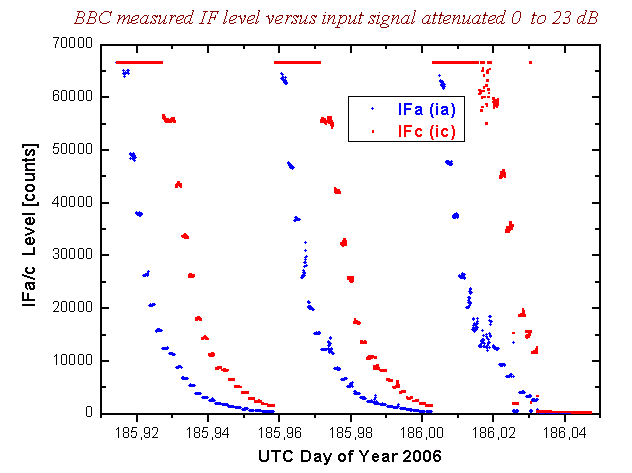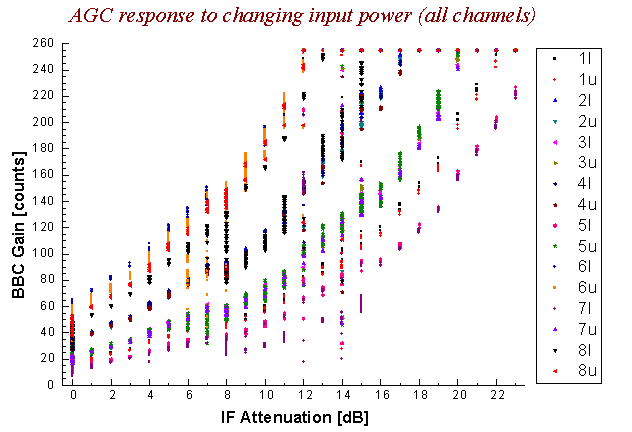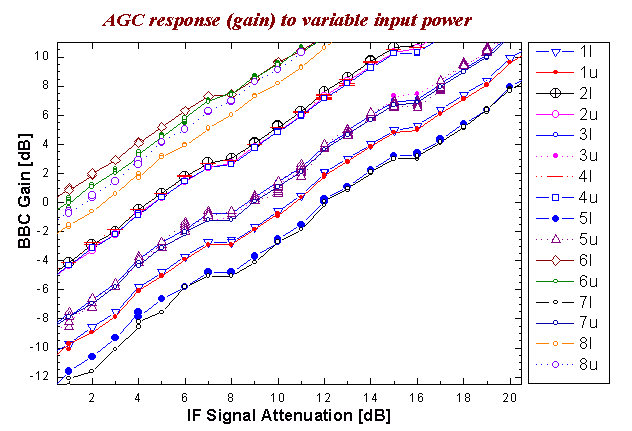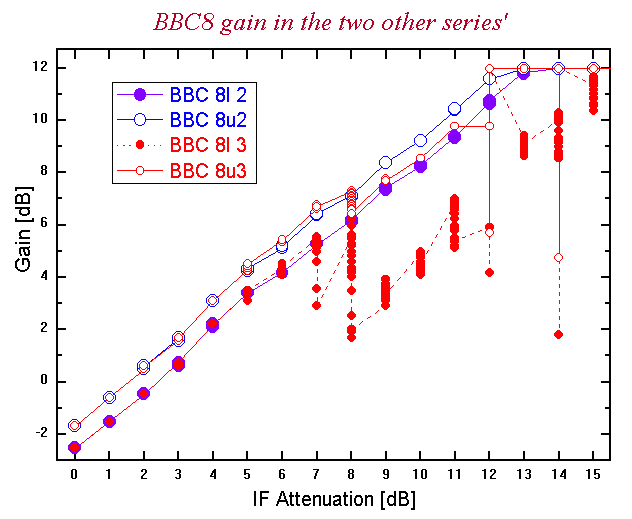
| IF signal level as seen by the BBC at the 'c' and 'a' channels (RCP an LCP, respectively). All the 1728 measurements included. In most of the cases one irregular spot or grouping of 24 points corresponds to one value of the external attenuator. Note the many overflowed values (saturation of BBCs, value being set arbitrarily to 66666) in the c-channel seen at the figure top whereas the a-channel overflowed only during the very first step of attenuation (at 0 dB). As seen, one complete series of measurements has been repeated three times. During the second and third run some data are spoiled by RFI or instabilities in our system. |

| Part of the previous figure data presented so as to better expose the two clear discontinuities in the attenuation stepping after each 8 steps (nominal values of 7 and 8 dB as well as 15 and 16 dB result in nearly the same attenuation). Note that this is a property of our external attenuators, and not of the BBC attenuators. |

| Individual channel readings (response of the tpgain command). The legend to the right lists the BBC number and sideband (u and l stand for upper and lower sideband, respectively). This figure consists of 24×24×3×16 = 27648 points plotted. |
real*8 function BBCdB(icount)
c Converts gain number, icount, to BBC gain in decibels, BBCdB
real*8 dB(0:255), BBCdB
c Table of dB gain setting against gain number for BBCs, taken
c from NRAO code subroutine "module/bblvcode.c" (256 levels)
data dB/
&-99.99,-36.16,-30.14,-26.62,-24.12,-22.18,-20.60,-19.26,
&-18.10,-17.08,-16.16,-15.34,-14.58,-13.89,-13.24,-12.64,
&-12.08,-11.56,-11.06,-10.59,-10.14, -9.72, -9.32, -8.93,
& -8.56, -8.21, -7.86, -7.54, -7.22, -6.92, -6.62, -6.34,
& -6.06, -5.79, -5.53, -5.28, -5.04, -4.80, -4.57, -4.34,
& -4.12, -3.91, -3.70, -3.49, -3.30, -3.10, -2.91, -2.72,
& -2.54, -2.36, -2.18, -2.01, -1.84, -1.68, -1.52, -1.36,
& -1.20, -1.05, -0.90, -0.75, -0.60, -0.46, -0.32, -0.18,
& -0.04, 0.09, 0.23, 0.36, 0.49, 0.61, 0.74, 0.86,
& 0.98, 1.10, 1.22, 1.34, 1.45, 1.57, 1.68, 1.79,
& 1.90, 2.01, 2.11, 2.22, 2.32, 2.42, 2.53, 2.63,
& 2.73, 2.82, 2.92, 3.02, 3.11, 3.21, 3.30, 3.39,
& 3.48, 3.57, 3.66, 3.75, 3.84, 3.92, 4.01, 4.09,
& 4.18, 4.26, 4.34, 4.42, 4.50, 4.58, 4.66, 4.74,
& 4.82, 4.90, 4.97, 5.05, 5.12, 5.20, 5.27, 5.35,
& 5.42, 5.49, 5.56, 5.63, 5.70, 5.77, 5.84, 5.91,
& 5.98, 6.05, 6.11, 6.18, 6.25, 6.31, 6.38, 6.44,
& 6.51, 6.57, 6.63, 6.70, 6.76, 6.82, 6.88, 6.94,
& 7.00, 7.06, 7.12, 7.18, 7.24, 7.30, 7.36, 7.42,
& 7.47, 7.53, 7.59, 7.64, 7.70, 7.75, 7.81, 7.86,
& 7.92, 7.97, 8.03, 8.08, 8.13, 8.19, 8.24, 8.29,
& 8.34, 8.39, 8.44, 8.50, 8.55, 8.60, 8.65, 8.70,
& 8.75, 8.80, 8.84, 8.89, 8.94, 8.99, 9.04, 9.08,
& 9.13, 9.18, 9.23, 9.27, 9.32, 9.37, 9.41, 9.46,
& 9.50, 9.55, 9.59, 9.64, 9.68, 9.73, 9.77, 9.81,
& 9.86, 9.90, 9.94, 9.99, 10.03, 10.07, 10.11, 10.16,
& 10.20, 10.24, 10.28, 10.32, 10.36, 10.40, 10.44, 10.48,
& 10.52, 10.56, 10.60, 10.64, 10.68, 10.72, 10.76, 10.80,
& 10.84, 10.88, 10.92, 10.96, 10.99, 11.03, 11.07, 11.11,
& 11.15, 11.18, 11.22, 11.26, 11.29, 11.33, 11.37, 11.40,
& 11.44, 11.48, 11.51, 11.55, 11.58, 11.62, 11.65, 11.69,
& 11.72, 11.76, 11.79, 11.83, 11.86, 11.90, 11.93, 11.97/
icoun=max0(0,min0(255,icount))
BBCdB=dB(icoun)
end
|
|
FORTRAN code used to convert the FS readings of gain number into BBC gain expressed in decibels. |
.gif)
| Graphical presentation of the function implemented in the above BBCdB subroutine |

| Gain in all the 16 channels during the first of the three series' of measurements, that apparently was least affected by interference. Parallelism and approximate straightness (by sections) of the lines corresponding to different channels is a satisfactory evidence that our BBCs behaviour is close to the NRAO specifications. The BBC8 is a surprising exception. Here the discontinuity seen in the IF channels at 7/8 dB and 15/16 dB attenuation is somehow entirely compensated for! This behaviour of BBC8 is equally clearly evident also in data of the second series, and only partly in the third series, where strong interference badly spoil the picture (see the following figure). |

|
Same as in previous figure but for BBC8 channels only and data from the series 2 and 3 (points marked as BBC 8l/u 2 and 3, respectively). |